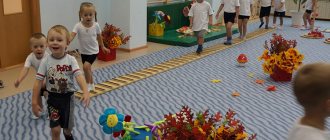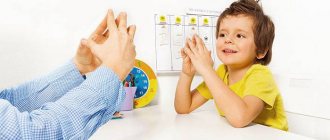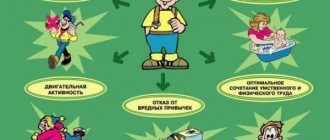MAGAZINE Preschooler.RF
Classes to develop emotional well-being in preschoolersAinullina Elena Nikolaevna BMKDOU "Kindergarten No. 10" Teacher-psychologist Berezovsky, Sverdlovsk region
One of the current trends in the development of society in Russian reality today is the attitude towards childhood as an intrinsic stage of human development, in which education is an institution of socialization and individualization of the child, notes A. Asmolov.
A significant factor influencing personality development is emotional well-being. The main content, which consists in a consistently positive, comfortable emotional state of the child, which is the basis of a person’s entire relationship to the world and influences the characteristics of experiencing a family situation, the cognitive sphere, emotional-volitional, style of experiencing stressful situations, relationships with peers (V.I. Pereguda , I.Yu. Ilyina, G.A. Sverdlova, E.P. Arnautova, etc.) [3]. The presented characteristics are included in the list of targets of the Federal State Educational Standard for Educational Education, and are one of the significant results of the implementation of the standard. The proposed activities are part of the program for developing emotional well-being in preschoolers “Visiting a Butterfly” and allow you to develop the emotional well-being of preschoolers.
Purpose and objectives of the classes:
- Expand the conditions for experiencing a predominantly positive mood background.
- Create a situation of experiencing success and realizing it.
- Form a positive image of interaction with peers.
- Create conditions for experiencing comfort (as the absence of external threat and physical discomfort),
- To form an adequate experience of how others evaluate the results of the child’s activity.
Expected result: development of emotional well-being, empathy, emotional intelligence, communication skills, self-esteem.
Participants are 4-5 years old.
Lesson 1 (Program block – introduction: creating conditions for experiencing comfort: absence of external threat and physical discomfort).
The goal is to form a development group.
Tasks: arrange for group members to meet a psychologist; create conditions for acquaintance and acceptance of the rules of group activities; reduction of emotional stress; creating a favorable psychological atmosphere in the group; creating a situation of success.
Materials: butterfly toy, pictures of butterflies (3-4 pictures), musical accompaniment - P.I. Tchaikovsky "Polka" , music player.
Progress of the lesson. Greetings. The goal is motivation for activity, initial acquaintance with the rules in the classroom. The form is conversation.
Description: A psychologist comes to the group, gathers children around him and invites them to go with him on a trip to one of his friends. At the same time, he warns that he will take the guys on a trip if they promise to all go together (not run away), speak in turns, walk together (help each other, don’t fight, don’t offend each other) and as soon as they hear three claps, there should be silence . After which he invites everyone to get on the train and go for a visit.
Game "Steam Locomotive" . The goal is to create an emotional mood for the lesson. Form is a game. Description: the psychologist invites the children to get on a train and hit the road. At the same time, he suggests singing a song along the way: The locomotive is traveling, the locomotive is traveling, it took its friends to visit. Two pipes, a hundred wheels, he took his friends to visit. He brought two pipes and a hundred wheels to visit his friends. Tu-tu-tu...
Meet the butterfly. The goal is to develop self-presentation skills and maintain interest in activities. Form – conversation, exercise. Description: a psychologist with children drives up on a “steam locomotive” to a toy – a butterfly – lying on the table. The psychologist draws attention to how beautiful his familiar butterfly is and invites the children to sit on the carpet around the toy. “Butterfly” welcomes her guests and tells them that her name is butterfly Zoya and she loves to fly and relax on flowers. He asks what each child’s name is and what he likes to do, and shakes everyone’s hand.
Game "Flight of the Butterflies" . The goal is to reduce muscle tension, master the rule of three claps and silence, increase the emotional background, and create conditions for self-expression. Form is an active game. Description: “butterfly” invites the children to play her favorite game and imagine that they have become butterflies and are flying and dancing beautifully over the field. But as soon as three claps sound, the butterflies should immediately sit on the flowers and silence should fall. The game is played with musical accompaniment - P.I. Tchaikovsky "Polka" . The game is played in 3-4 steps.
Blitz survey. The goal is to create a situation of success. The form is conversation. Description: “Butterfly” invites everyone to sit down, praises them for their beautiful dancing and attentiveness. And he begins to show photographs of his family (pictures of butterflies). The psychologist asks the children what color this butterfly is, what shape the wings are, what size.
Parting. The goal is to accept the rules of the lesson and develop reflection. The form is conversation. Description: “Butterfly” praises the guys that they know so much and how friendly they played with her. He points out that this is because the guys followed the rules: everyone played together (don’t run away), they spoke in turns, helped each other, and after three claps there was silence.. He asks the guys if they remember what they played with the butterfly. Invites them to visit next time, says goodbye to everyone
Game "Steam Locomotive" . The goal is to create an emotional conclusion to the lesson. Form is a game. See above.
Lesson 2 (Program block – introduction. Creating conditions for experiencing comfort: absence of external threat and physical discomfort).
The goal is to form a development group and create an experience of comfort.
Tasks: organize acquaintance and acceptance of the rules for group classes; reduction of emotional stress; creating a favorable psychological atmosphere in the group; creating a situation of success.
Materials: butterfly toy, colored ottomans, rectangles of colored paper corresponding to the colors of the ottomans - “tickets” , laptop, film “Luntik: Quarrel” , musical accompaniment - P.I. Tchaikovsky children's album "Kamarinskaya" .
Progress of the lesson. Greetings. Steam locomotive (lesson 1).
Meeting with a butterfly. Game "Find the ticket" . The goal is motivation for activity, creating a situation of success. Form is an active game. Description. The guys sit around the butterfly and greet it. The butterfly “flies up” to each child, strokes the hand, and greets. Offers to visit the cinema. In order to get into the cinema you need tickets (shows an example of a ticket - a rectangle made of colored paper). children need to find and take one ticket posted around the office and come to the butterfly.
A walk to the movies. The goal is to consolidate ideas about the rules of behavior and awareness of the impact of one’s behavior on safety. Form – viewing and discussion of the cartoon. Description. Butterfly suggests how to take the seats in a real cinema that are written on the tickets: sit on an ottoman of the same color as the ticket. Then he turns on the cartoon (film “Luntik: Quarrel” ). After watching the cartoon, the butterfly asks questions: did you like the film; what happened to the heroes; why did this happen; how they got out of the situation; what we need to do to prevent this from happening (remember the rules).
Game "Flight of the Butterflies" . The goal is to reduce muscle tension, learn the rule of three claps and silence, increase the emotional background, and create a situation of success. Form is an active game. Description: the “butterfly” invites the children to help her collect pollen from the flowers. When the music starts, the children begin their flight, as soon as three claps sound there should be silence, and the butterfly names the color of the flower, the children need to sit on the flowers of the named color. Flowers made of paper in primary colors are hung around the room. The game is played with musical accompaniment - P.I. Tchaikovsky children's album "Kamarinskaya" . The game is played in 3-4 steps.
Parting. The goal is to accept the rules of the lesson and develop reflection. The form is conversation. Description: “Butterfly” asks the guys what they did at a party today. Invites them to visit next time, says goodbye to everyone.
Locomotive. (See lesson 1)
Lesson 3 (Program block - experiencing situations of success, and its awareness by students)
The goal is to create a situation of success for students.
Objectives: create conditions for children to experience comfort; create situations of success and its awareness; reduce emotional stress; create a favorable psychological atmosphere in the group.
Materials: A3 colored sheets (according to the number of children), musical accompaniment - P.I. Tchaikovsky children's album "Kamarinskaya" , "The Nutcracker: Dance of the Sugar Plum Fairy" , the sound of rain, music player, colored pencils, glue, picture of a rainbow, colored paper mugs, umbrella.
Progress of the lesson. Greetings. Steam locomotive (lesson 1).
Magic portraits. The goal is to create a visual system for realizing success. The form is conversation. Description. The children “come” to the office, the music “The Nutcracker: Dance of the Sugar Plum Fairy” , and in the middle of the carpet there are colored A3 sheets all around, according to the number of children. The psychologist says that this is a surprise gift from the butterfly, these are “magical portraits” . Invites the children to sit in front of each “portrait” . He says that the portrait on which the child sat opposite will be his, and the portrait shows not just his face, but what the person does very well, what he can do.
Self-portrait. The goal is to begin the process of identification with the “magic portrait” . Form - drawing. Description. The psychologist says that in order for a magical portrait to really become yours, you need to get to know it and draw yourself in a frame. Invites the guys to take portraits and sit at the table. Now no one will confuse your portrait and he knows whose it is.
Game "Rain" . The goal is to create a situation of success and experience comfort. Form is an active game. Description. The psychologist looks out the window and says that the clouds are gathering and it will rain soon. He asks the guys what they do when it starts to rain (they hide under an umbrella). Now, while the music is playing, you will be flying around our clearing like butterflies, and when you hear the rain, immediately run under an umbrella so as not to get wet. An audio recording is turned on where music and the sound of rain alternate. Repeat 2-3 times.
Rainbow Poll . The goal is to create a situation of success and experience comfort. Form – survey. Description. The psychologist points to a picture of a rainbow and says that the rain has stopped and a rainbow has come out, offering to come up and look at it. The children stand in a circle. The psychologist draws a colored circle and asks each child what color it is; if the child guesses right, the psychologist gives the circle to him.
Magic portraits. The goal is the experience of success and the awareness of success. Form – conversation, application. Description. The psychologist asks the children what they did in the clearing today. Gives everyone a picture for their speed and attentiveness (there is a running child in the picture). And he suggests sticking colors and pictures onto magical portraits and seeing what they come up with. And go to the group, leaving portraits in the clearing.
Locomotive. See lesson 1
Lesson 4 (Program block - experiencing comfort in the presence of other people and situations of interaction with peers).
The goal is to create comfortable interaction between students and peers.
Objectives: create conditions for children to experience comfort; create situations of success and their awareness in situations of relationships with peers; reduce emotional stress; create a favorable psychological atmosphere in the group.
Materials: magic portraits, glue, colored pencils. Pictures of children holding hands. Musical accompaniment: P.I. Tchaikovsky "Children's Album" , large coloring sheet with patterns, butterfly toy.
Progress of the lesson. Greetings. Steam locomotive (lesson 1).
Meeting with a butterfly. The goal is to maintain interest in the activity. Form – conversation, exercise. Description: a psychologist with children drives up on a “steam locomotive” to a toy – a butterfly – lying on the table. Placed on the carpet around the toy. “Butterfly” greets her guests and tells how she missed her even when she was playing with her family. He asks me to tell you about the magical portraits.
Presentation of magical portraits. The goal is for children to realize success and develop self-presentation skills in a peer group. Form is a story about yourself. Description. “Butterfly” asks the children to show their magical portraits and tell about them. The children take their portraits and sit in a circle again. The butterfly says that she also has her own magical portrait and she also wants to show it to the children (she shows an example of how you can tell about yourself using pictures in a portrait). At the end he praises the children.
Flight of butterflies. The goal is to reduce muscle tension, increase the emotional background, and create a situation of success. Form is an active game. Description: The psychologist invites the children to fulfill the butterfly’s request and help her collect nectar from the flowers. When the music starts, the children begin their flight, as soon as three claps sound there should be silence, and the butterfly names the color of the flower, the children need to sit on the flowers of the named color and collect pollen. Flowers made of paper in primary colors are hung around the room. The game is played with musical accompaniment - P.I. Tchaikovsky Children's album "Polka" . The game is played in 2-3 steps.
Color the leaf. Create situations of success and their awareness in situations of relationships with peers. Form – group productive activity: drawing. Description. The butterfly shows the children what an unusual leaf she brought from that magical land where she was visiting, only it is black and white. Offers to make it more joyful and bright. The psychologist invites the children to sit down at the table, show each child in turn which part of the sheet he will color, and then start drawing. During the activity, music by P.I. is played. Tchaikovsky "Children's Album" . At the end of which he thanks all the guys and praises them for how they drew together. He hands each person a picture of children holding hands [4].
Steam locomotive (See lesson 1).
Lesson 5 (Program block - experiencing comfort in the presence of other people and situations of interaction with peers).
The goal is to create comfortable interaction between students and peers.
Objectives: create conditions for children to experience comfort; create situations of success and their awareness in situations of relationships with peers; reduce emotional stress; create a favorable psychological atmosphere in the group.
Materials: butterfly toy, A4 artist’s picture and small ones according to the number of children, magic portraits, glue, Gouache and brushes according to the number of children, “easel” - vertically fixed plexiglass in the amount of half the group. Musical accompaniment by C. Debussy “Moonlight” , music player.
Progress of the lesson. Greetings. Steam locomotive (lesson 1).
Meeting with a butterfly. The goal is to maintain interest in the activity. The form is conversation. Description: a psychologist with children drives up on a “steam locomotive” to a toy – a butterfly – lying on the table. Placed on the carpet around the toy. “Butterfly” greets its guests by shaking hands and saying their name, and suggests trying to say hello in a circle this way.
Drawing "Two Artists" . The goal is to create situations of success and their awareness in situations of relationships with peers. Form - productive activity in pairs: drawing. Description. The butterfly tells the children that she saw a real artist in the clearing today, shows a picture of the artist with paints and an easel. He asks the guys: do they know who the artist is, what he does, what is drawn in the picture. He suggests trying to become artists, but unusual ones; the picture will need to be drawn together. To do this, a plexiglass “easel” , and each is given gouache and a brush. Children are seated on different sides of the “easel” and asked to take turns drawing one drawing on the glass, so they will get the overall picture. Before starting to draw, children are asked to say and show the place where they will draw. The completion of the task is accompanied by the music of C. Debussy “Moonlight” . At the end of the work, I invite the children to see who has achieved what - to look at the exhibition of artists.
Game "Paint" . The goal is to reduce muscle tension and create a situation of success. Form is an active game. Description. Two lines are drawn. The driver is chosen - paint, he stands between these lines. Everyone else is on one of them. The driver turns away from the children and names a color and turns around. If such a color is in the child’s clothes, then he can calmly walk to the other side, showing the color. If not, he must run so that the driver does not grease him.
Magic portraits. (See lesson 3, task: paste a picture of the artist).
Steam locomotive (See lesson 1).
Bibliography:
- Order of the Ministry of Education and Science of the Russian Federation (Ministry of Education and Science of Russia) dated October 17, 2013 N 1155 Moscow “On approval of the federal state educational standard of preschool education” [Electronic resource] // Russian newspaper. – 2013. – No. 6241.
- Kurzhaeva, N.Yu. Program of psychological and pedagogical classes for preschoolers 4-5 years old [Text] / N.Yu. Kurzhaeva. – St. Petersburg: Rech, 2014. -160 p.
- Fillipova, G.G. Psychology of motherhood [Text. ]: textbook allowance / G.G. Filippova. - M.: Institute of Psychotherapy, 2002. - 240 p.
- Khukhlaeva, O.V. Practical materials for working with children aged 3-9 years [Text] / O.V. Khukhlaeva. - M.: Genesis, 2007. - 176 p.
| Next > |




